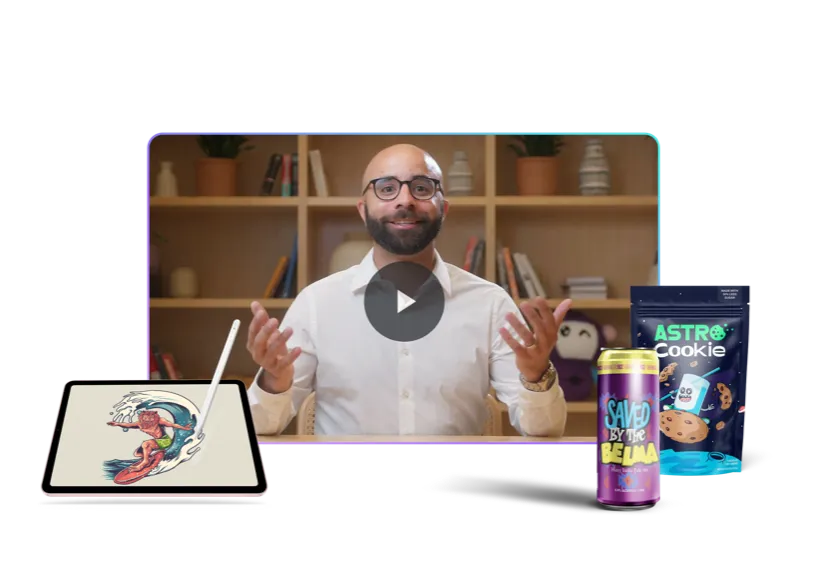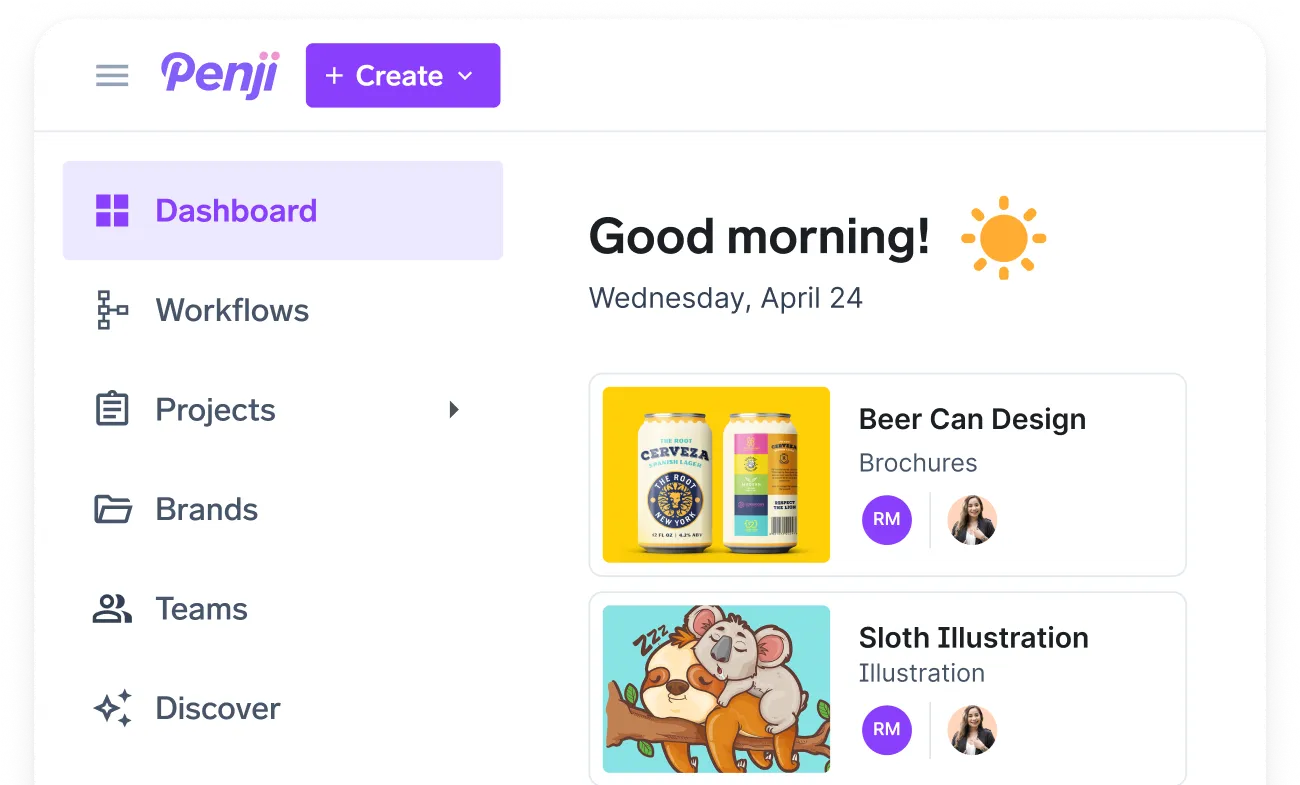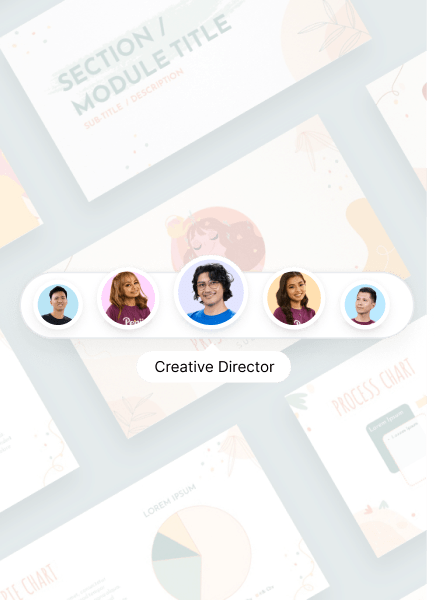![[Unified Purpose] Carrie Grover from Tracy Community Connections Center Ep. 20](https://penji.co/wp-content/uploads/2025/08/BLOG-IMAGE-Carrie-Grover.jpg)
Opening Game: Guilty Pleasures
Shannon Donnelly (SD): Alrighty. Hello, everyone, and thank you for joining us. So we are just going to get right into a game today to get our creative juices flowing. So I want you to talk about your guilty pleasure right now. It could be a TV show. It could be a book. It could be anything. Just explain it in less than a minute. Convince us that we should also have it as a guilty pleasure.
Keri Grover (KG): Right, my current guilty pleasure is definitely White Lotus. I was really late to the game. I only started watching season one like a month or two ago, got totally into it, watched season one, season two, and now I’m into season three. I’m just like, it’s the best. I love it.
SD: Oh, you really sped right through it.
KG: I really did. I was really committed.
SD: That means, well, I’m already, I think I am a bit convinced to watch it. I’ve had many people tell me to, and I think that there’s enough now that I feel like I need to.
KG: Yeah, just really fascinating commentary on human beings and social issues that are very interesting.
SD: I do like a unique take. I know it’s also kind of funny and comical, which I enjoy a little bit. I know that I get very overwhelmed when watching a lot of serious content because the world is serious. So you usually want to get out of the seriousness, or I do personally. So I completely understand. But I think that I will definitely get into it. I know it’s a very unique show that a lot of people do say good things about.
Introduction to the Podcast and Guest
SD: Well, hello everyone again. Welcome to Unified Purpose. This is the podcast where we share inspiring tales of compassion, resilience, and community spirit. I’m your host Shannon, Penji’s Partnership Coordinator, and I’m joined here today with a very special guest, Keri Grover from Tracy Community Connection Center. Thank you so much for joining me today. I really appreciate it. And thank you for getting the ball rolling with our fun little question.
KG: Thank you so much for having me. I’m happy to be here. I really appreciate it.
About the Organization
SD: Could you start by telling us a little bit about yourself and your organization? I think this would be a great way to start up. Maybe you’d introduce yourself a little bit differently than I would. So anything that you think is relevant to share with our audience?
KG: Sure. So like you said, my name is Carrie Grover. I’m the executive director at Tracy Community Connection Center. We are a local nonprofit that cares for low-income and homeless families and individuals. And we have a staff of eleven who manages everything from street outreach to all of our services, which include mobile showers, mobile laundry, eviction prevention and rental assistance, and case management.
SD: That is wonderful. It’s nice to see that there’s a multi-step process. I know there’s a lot of organizations that deal with homeless individuals that address a very minor thing, which isn’t bad because I think that sometimes when you focus on something, it’s easier to know that you’re doing it well. But I also love to see a comprehensive approach to the homelessness issue, because I think that sometimes you will help with one thing, but they really need help with something else. And it’s a difficult balance to make sure that they’re covered in every possible facet.
KG: Yeah, we absolutely try to provide what we call whole person care. So looking at all of the issues that individuals may be facing and addressing them one by one, trying to really get to the root of their homelessness rather than just dealing with the immediate issue at hand.
Strategies for Approaching and Helping the Homeless
SD: So what are some different strategies that you put into place to approach someone that is homeless or may need help?
KG: We really approach our work through a relationship model where we build relationships with individuals, and it may take time, sometimes years. My staff, especially the outreach staff, have fantastic patience and they are willing to invest time in the relationship with these individuals so that when they are ready to receive services, they know who to approach and they know where to find help. It may take years, but I can tell you several examples of individuals who will come to my staff and say, “Okay, I’m ready to get clean and sober. Okay, I’m ready to start addressing my mental health needs. Okay, I’m ready to look for employment.” It often takes a long time to get up to that point. That relationship piece is key for us.
SD: I really love that understanding. I do know that especially with issues of addiction, people will only do something about it when they want to and not because someone is making them. A lot of people think that if you just throw someone in rehab, they’re going to be better and everything will be fine, but that’s not the case. Addiction is a very difficult thing to handle. If that is what led to them being homeless, then it’s a much more complicated issue than other situations. It’s good to recognize that it’s very much a choice for them—not to be homeless, but to want to do something about their situation—and to acknowledge that without pressuring them. When people feel boxed in, they’re not necessarily happy to do something about their situation.
KG: Yeah. We’ve seen time and time again where we do get people into programs that they’re not really ready for, and then they just self-exit. There are some programs and services available that really aren’t always—some of them are once-in-a-lifetime opportunities. We don’t want people to use them before they’re ready. Whatever it may be with their insurance or eligibility, we don’t want to burn through those opportunities until they’re ready to fully utilize them appropriately.
Prioritizing Services and Preventing Crisis
SD: That makes a lot of sense. So with the range of services that you have, how do you prioritize certain ones? How do you choose to put more money into certain facilities or resources? Is it based on population, how many people need to use something, or something else?
KG: We maintain what we call our client hot list that identifies who is in the most crisis at the moment and who needs the most attention. The case managers and outreach workers will focus their attention on those individuals who may be on the hot list that week. In terms of prioritizing services, we really just try to provide consistency—weekly showers, weekly laundry, weekly case management—all with consistency so that whoever happens to be in crisis, yes, we are going to help manage that, but we also hope the consistency of services will prevent crisis from coming up if possible.
SD: That makes complete sense. It’s about being prepared for everything.
Mobile Showers and Laundry Services
SD: This is maybe just a curiosity question, but I’ve never heard of mobile showers. Can you explain that to me? I’ve done a lot of volunteering with homeless and formerly incarcerated individuals in Philly, but I’ve never heard of this concept.
KG: Yeah, it’s a unique program. There are certainly other programs throughout the country that offer it as well. Essentially, it’s a trailer that we tow with a truck, and it has two showers—one ADA-compliant and one standard. We pull it to a church parking lot three times a week. We set up, connect hoses to the water and sewers, and clients can then show up and take a shower. We also provide food, water, phone charging stations, case management, some minor medical care, COVID tests sometimes, and other resources while people wait for their shower. The mobile laundry is exactly the same—it’s a trailer with six washers and six dryers that we pull to a church parking lot, hook it all up, and allow people to do a load of wash for free.
SD: That is incredible. I love the idea of that because maybe there’s just no one doing it in Philly, or maybe I’m not aware of it. We do have centers like the Hub of Hope, which is below our municipal building in Philly, that allow people to wash clothes and sit indoors during bad weather. They may get coffee in the winter or snacks. I don’t think they provide full food services, but they do have resources for people coming in. I’ve never heard of this concept, so it’s exciting to me. I love hearing about new things that are helping people. Unfortunately, there’s a stigma around people who aren’t visibly clean. If that’s what someone needs to get a job and get on their feet, it’s incredibly valuable, not to mention important for health.
KG: Absolutely. Not to mention just restoring that sense of dignity. You know how good you feel after a shower? If you didn’t have that, it could affect your mental health, physical health, ability to get jobs—all the things you already mentioned.
SD: Exactly. I love the thought of that. There are so many things that lead to homelessness, but there are all these minor things—like restoring dignity—that people don’t consider because they’re not deemed necessary.
Addressing the Root Causes of Homelessness
SD: Speaking of the different things that contribute to this problem, are you doing anything to remedy the root causes of homelessness? I know you mentioned earlier trying to do it on an individual basis, but is there any policy you’re trying to change or similar efforts?
KG: That’s a good question. We work with low-income families who are at risk of becoming homeless and try to keep them housed. Our eviction prevention program is one effort because it’s a lot easier to keep somebody housed than to rehouse them once they become homeless. If there’s a family facing eviction, we partner with a county agency to help pay one month of rent directly to the landlord to keep that family housed. We’re really passionate about preventing homelessness from starting if we can. As far as advocacy, we work with our local continuum of care and other local nonprofits to ensure legislation is happening in helpful ways. But it’s a tricky time politically, with some Supreme Court cases about homelessness affecting things, especially in California. It’s an ongoing challenge, but we aim to be a good partner and advocate.
Building Trust with Clients
SD: I understand the struggles, especially with political changes that may negatively affect nonprofits. Switching gears, you said earlier that you work with individuals to find the root cause of their problem and that you work with them until they feel comfortable. How do you get them to trust you? What does that process look like?
KG: When they come and receive services like showers or laundry, that builds a relationship of trust. It’s an ongoing, consistent service we provide. Mostly people self-refer—they need help and they’re there because they want to be. The case managers sit down and do an intake with them, anywhere from thirty minutes to an hour, hearing their story, documenting challenges, and collecting information to strategize with the client. That initial intake and conversation provides trust.
SD: When you do this process, do you keep records of the clients in order to interact with them in the future so they feel cared about?
KG: Yes, and that’s federally mandated. To receive funding through different grants, we use the Homeless Management Information System, an online database where we track everything we do. Everyone else in the county does the same, which reduces duplication of services and improves partnerships. For example, if someone receives eviction prevention resources from us, they can’t go to another agency for the same funding. It also allows us to refer clients to other agencies for services we don’t provide, like medical care or behavioral health.
Partnerships and Collaborations
SD: That’s interesting. People who don’t support helping low-income or homeless individuals often assume they take advantage of the system, but with this tracking, they literally can’t.
KG: Exactly. While someone might try to game the system, we have checks and balances between agencies and funding partners to prevent that.
SD: Speaking of partners, what kind of organizations or agencies do you partner with to provide additional services?
KG: We partner with hospitals, especially Sutter, to ensure discharged patients have support like hotel vouchers and food so they don’t end up back in the ER quickly. We also partner with behavioral health providers, sober living environments, homeless shelters, food banks, domestic violence providers, and safe houses. We refer clients to other social services like food stamps and cash aid.
SD: How do you make these connections?
KG: Many come from longstanding relationships. My case managers have years of experience and know who to call for various needs. We also reach out to new resources, invite agencies to present to our staff, and keep an ongoing update of resources.
Employment Resources
SD: Do you have staffing agencies specifically for homeless individuals, like we do in Philly?
KG: Not that I know of. We work with JobWorks, a government agency helping welfare recipients find jobs, and employers get benefits for hiring from that pool.
SD: I used to work for one in Philly that also connected with sober living facilities and hosted conferences. If there’s one near you, I’ll share it with you. I think it fills a big gap between addressing immediate needs and helping people reenter the workforce.
KG: I’d definitely be interested in that. We also value having staff with lived experience of homelessness. They bring insight and help build trust with clients, showing them that recovery is possible.
Measuring Success
SD: How do you measure the success of your organization?
KG: We measure it in two ways. First, the amount of services provided—our numbers more than doubled from 733 individuals in 2023 to 1,600 in 2024, showing our reach. Second, we focus on outcomes, like the number of individuals who remain housed after receiving services and the number of unsheltered bed nights provided. We also track success through one-on-one stories, like reuniting clients with family.
A Success Story
SD: Can you share a specific story?
KG: A few weeks ago, our outreach team found a man living in his car with an untreated diabetic foot infection. They took him to the ER, where doctors immediately amputated his foot, saying we saved his life. We housed him temporarily, contacted his family in Texas, bought him a plane ticket, and ensured he got safely to the airport. He’s now reunited with his family.
SD: That’s incredible. Many homeless people have family but can’t afford to get to them. A plane ticket can be out of reach.
KG: Exactly. We usually buy train tickets for cost-effectiveness, but in his condition, flying was the best option. Family reunification is always a big goal for us, as long as it’s safe for the client.
Long-Term Goals
SD: Since we’re coming up on time, can you share your long-term goals?
KG: I’d love to open a warming and cooling center in our city—a welcoming day center where people can escape extreme weather, have coffee, and feel acknowledged. I’d also like to hire more case managers to handle our workload and prevent staff burnout.
SD: That’s a wonderful goal. Facilities like that save lives, not just by providing shelter but also human connection. Many homeless individuals feel invisible because people ignore them. Teaching compassion to the public is part of the solution.
KG: Absolutely. If we can humanize homeless people and treat them as individuals, we’ve succeeded. Many of us are just a few paychecks away from the same situation.
SD: And for those who feel helpless when they see someone in need, reach out to local organizations. Even small monthly donations help.
KG: Exactly. Your contribution supports the work being done and makes you part of the solution.
SD: That’s a wholesome note to end on. Thank you so much for joining me today and sharing about TCCC. I encourage our listeners to support organizations like yours.
KG: Thank you so much for having me.
SD: And thank you everyone for listening or watching. Please consider participating in and supporting organizations like Keri’s.
Long-Term Goals & Final Reflections
SD: …and that’s not necessarily the same for every person.
KG: Absolutely.
SD: Since we’re coming up on time, I want to leave off on this: thank you so much for joining me today. This has been lovely, and it was really nice to learn more about TCCC. Can you tell me what your long-term goals are for the future? Maybe something ambitious that you’d love to accomplish, even if it feels like a stretch.
KG: Oh, I love that question. My goal would be to establish a warming and cooling center in our city. We do have a shelter, but I don’t operate it—the city does. I envision more of a day center where we could also house our offices, creating a welcoming environment for people to spend time. California gets cold and rainy in the winter and very hot in the summer. Sometimes what people need most is a cup of coffee and someone to say hello. I’d love to provide that, along with more case managers because we can’t handle the load as it is, and to continue supporting the staff I have so they don’t burn out.
SD: I think that’s lovely. I see the need for warming and cooling facilities, and I know these save lives—not just for shelter but also for the camaraderie and social connection. Many people experiencing homelessness are ignored simply because others are uncomfortable. I spoke to an organization in California that connects people so they have someone to talk to. That’s an incredible aspect, because homelessness can make you feel less than human. I love that you want a space where people are acknowledged and treated like people.
KG: I think if nothing else, if we can humanize homeless people, we’ve succeeded. They’re just people facing a hard time. Many of us are only a couple of paychecks away from the same situation. Seeing people as human beings is really all we can and should do.
SD: Exactly. And people don’t have enough empathy or understanding. Many can’t imagine going without food or water for days. That changes how you act, but it doesn’t make you less human—it makes you human. Teaching compassion is important, as is educating the public to be more understanding. The homeless don’t need pity—they need help. People often feel helpless because they don’t know what to do, but there are ways to help.
KG: I always say, reach out to your local organization and ask how you can help—donate, volunteer, advocate. Even five dollars a month can make a difference. The organizations are doing the work, and your support makes you part of it too.
SD: That’s a wonderful note to end on because it’s wholesome and a call to action for the audience. I really appreciate you coming on today. Learning about your organization was incredible. The compassion and understanding you show is inspiring.
KG: Well, thank you. Thank you so much for having me.
SD: And thank you everyone for listening or watching. Please make sure to participate in not just this organization but also others doing similar work. I appreciate you for watching and listening. Thank you so much.
https://www.linkedin.com/in/carrie-grover-4b078119a
About the author
Table of Contents
- Opening Game: Guilty Pleasures
- Introduction to the Podcast and Guest
- About the Organization
- Strategies for Approaching and Helping the Homeless
- Prioritizing Services and Preventing Crisis
- Mobile Showers and Laundry Services
- Addressing the Root Causes of Homelessness
- Building Trust with Clients
- Partnerships and Collaborations
- Employment Resources
- Measuring Success
- A Success Story
- Long-Term Goals
- Long-Term Goals & Final Reflections














